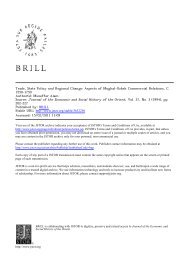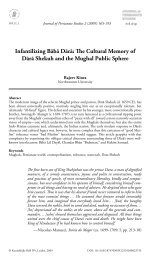The Mughals, the Sufi Shaikhs and the Formation of the Akbari ...
The Mughals, the Sufi Shaikhs and the Formation of the Akbari ...
The Mughals, the Sufi Shaikhs and the Formation of the Akbari ...
Create successful ePaper yourself
Turn your PDF publications into a flip-book with our unique Google optimized e-Paper software.
FORMATION OF THE AKBARI DISPENSATION 145<br />
something new <strong>and</strong> different from a mere loyalty to <strong>the</strong> shari’a which<br />
earlier Shaikh Baha al-Din had insisted upon. 22<br />
Ahrar’s power <strong>and</strong> triumph is to be explained perhaps more in terms<br />
<strong>of</strong> his enormous wealth <strong>and</strong> organizing skill than his spiritual <strong>and</strong><br />
sufi qualities, howsoever unusual <strong>and</strong> unprecedented such wealth <strong>and</strong><br />
skill might have been. He was probably <strong>the</strong> biggest single l<strong>and</strong>owner<br />
<strong>of</strong> Central Asia <strong>of</strong> his time. He possessed thous<strong>and</strong>s <strong>of</strong> acres <strong>of</strong> <strong>the</strong><br />
best irrigated l<strong>and</strong>s in Tashkent, Samarq<strong>and</strong>, Bukhara, Kashkadaria<br />
<strong>and</strong> o<strong>the</strong>r places. Besides, he also owned 64 villages surrounded with<br />
irrigating canals, 30 out-<strong>of</strong>-town orchards, 11 town estates <strong>and</strong> scores<br />
<strong>of</strong> commercial establishments <strong>and</strong> artisanal workshops, numerous<br />
arcades <strong>of</strong> shops <strong>and</strong> commercial stalls, town baths <strong>and</strong> water mills. 23<br />
<strong>The</strong>se properties were critical for <strong>the</strong> system <strong>of</strong> protection <strong>and</strong><br />
patronage that Ahrar developed, <strong>and</strong> which included an economic<br />
network made up <strong>of</strong> <strong>the</strong>se holdings <strong>and</strong> also his trading activities,<br />
both regional <strong>and</strong> international. <strong>The</strong>re were a large number <strong>of</strong> people<br />
<strong>and</strong> <strong>of</strong>ficials involved in this network, working with Ahrar himself at<br />
<strong>the</strong> central khanqah, <strong>and</strong> also spread out in various places all over<br />
Turkestan, Mawarannahr <strong>and</strong> Khurasan, to maintain <strong>and</strong> administer<br />
<strong>the</strong>se properties. Many <strong>of</strong> <strong>the</strong>m were not even his formal spiritual<br />
disciples. With this organized wealth, Ahrar was able to help both<br />
commoners <strong>and</strong> rulers in time <strong>of</strong> <strong>the</strong>ir financial difficulties. 24 It was<br />
in this way that he rearranged <strong>the</strong> forces <strong>of</strong> <strong>the</strong> Naqshb<strong>and</strong>i silsila to<br />
an unprecedented degree, building <strong>and</strong> consolidating his overriding<br />
position <strong>and</strong> uncontested power in <strong>the</strong> region.<br />
<strong>The</strong> nature <strong>of</strong> Ahrar’s unusual relations with <strong>the</strong> rulers <strong>of</strong> <strong>the</strong> region<br />
is illustrated from <strong>the</strong> behaviour <strong>of</strong> Sultan Ahmad Mirza who along<br />
with some <strong>of</strong> his nobles was initiated by him into <strong>the</strong> Naqshb<strong>and</strong>i order.<br />
22 I intend to maintain a distance here from <strong>the</strong> scholars who think that all through<br />
<strong>the</strong>ir history <strong>the</strong> Naqshbadi <strong>Sufi</strong>s have been involved in one or <strong>the</strong> o<strong>the</strong>r sort <strong>of</strong> political<br />
activity. I have <strong>the</strong>refore emphasized <strong>the</strong> words ‘new’ <strong>and</strong> ‘different’. See also Algar,<br />
‘Aspects <strong>of</strong> Naqshb<strong>and</strong>i history’, pp. 123–52, <strong>and</strong> Jo-Ann Gross, ‘Multiple roles <strong>of</strong> a<br />
<strong>Sufi</strong> Shaikh: Symbolic statements <strong>of</strong> political <strong>and</strong> religious authority’, in Gaborieau,<br />
Popovic <strong>and</strong> Zarcone (eds.), Naqshb<strong>and</strong>is, pp. 109–21.<br />
23 Compare O.D. Chekhovich, Samarq<strong>and</strong> Documents (Moscow, 1974), pp. 67, 72,<br />
125, 244 <strong>and</strong> 247; al-Kashifi, Rashhat, pp. 227, 228, 246 <strong>and</strong> 328. See also Jo-Ann<br />
Gross, ‘Economic status <strong>of</strong> a Timurid <strong>Sufi</strong> Shaikh: A matter <strong>of</strong> conflict or perception’<br />
in Iranian Studies, vol.21 (1988), pp. 84–104. For Ahrar’s estates in Kabul see also,<br />
Stephen F. Dale <strong>and</strong> Alam Payind, ‘<strong>The</strong> Ahrari Waqf in Kabul in <strong>the</strong> Year 1546 <strong>and</strong><br />
<strong>the</strong> Mughul Naqshb<strong>and</strong>iyyah’ in Journal <strong>of</strong> <strong>the</strong> American Oriental Society, vol.119, No.2<br />
(1999), pp. 218–33.<br />
24 Cf. Jürgen Paul, ‘Forming a faction: <strong>The</strong> Himayat System <strong>of</strong> Khwaja Ahrar’ in<br />
International Journal <strong>of</strong> Middle Eastern Studies, Vol.23 (1991), pp. 533–48.<br />
http://journals.cambridge.org Downloaded: 15 Feb 2011 IP address: 129.174.97.34






